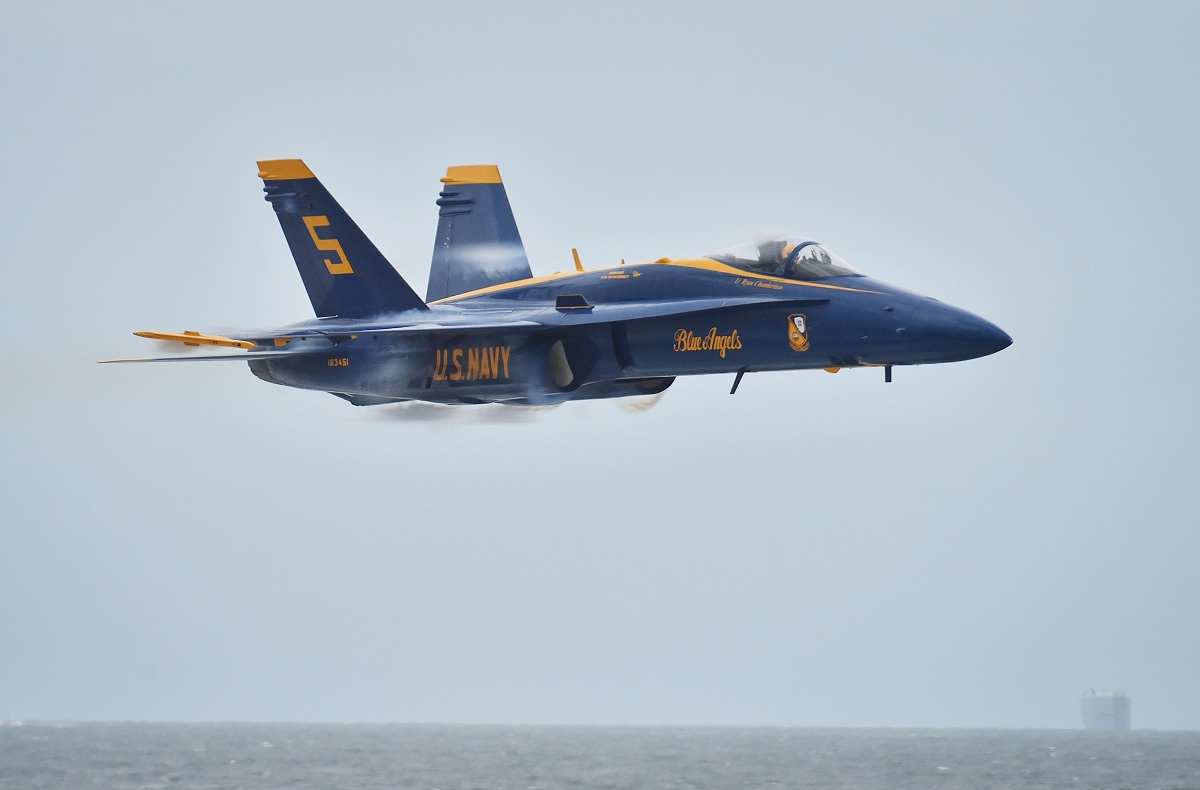One maneuver is likely to be modified or dropped: one proposal is for the diamond and solos to each drop one maneuver in order to streamline the show and improve the flow during the routine
As we have already explained, the Blue Angels are slated to upgrade from the F/A-18 Legacy Hornet to the F/A-18 Super Hornet soon.
As the actual jets, the new aircraft will be modified into a configuration specific to the Blue Angels role that requires the installation of a smoke generator, the removal of the fighter’s gun and missile launchers, and the ability to fly inverted for longer than a standard jet.
Still, the Rhino (as the Super Hornet is dubbed by its aircrews) is something more than a Legacy Hornet younger brother. In fact, when it is strictly compared to the F/A-18A/B/C/D, the F/A-18E/F is 25 percent larger and the two General Electric F414-GE-400 engines have increased the aircraft thrust by 35 percent over the older model. Moreover, an enhanced fuel capacity boosts the Super Hornet mission range.
Nevertheless, all these improvements have made the “Super” heavier than the “Legacy” Hornet and because of its extra weight making the Rhino, the new aircraft of the U.S. Navy Flight Demonstration Squadron could be a difficult task.
However now we now know a lot more about the U.S. Navy Blue Angels’ coming transition to the F/A-18E Super Hornet thanks to former Blue Angel #1, Captain Ryan Bernacchi. In fact, as explained in an interesting article that appeared on Airshow Stuff, he spoke to Newsradio 1620 in the team’s hometown of Pensacola, FL recently, and explained not only the difference between the team’s current F/A-18 “Legacy” Hornets and the coming Super Hornets but also the current status of the transition.
Bernacchi started by explaining why the transition is going forward in the first place. When the team began flying Hornets in the late ’80s, the modifications we have mentioned above were done to adapt their airframes for airshows. This work applied first to the F/A-18A and B variants and then to some older F/A-18C and D Hornets for shows as well. Although the team has continued to fly these older jets, they are aging and relatively few usable airframes remain eligible for the already approved modifications. In response, the Blues were forced to look at either pursuing younger Legacy Hornets or transitioning to Super Hornets.

Their findings are very interesting. Bernacchi says that even though the Legacy Hornets are now retired from active Navy service – as we have recently reported in fact the U.S. Navy F/A-18C final operational flight took place on Feb. 1– the vast majority of the youngest airframes are earmarked for service with the Marine Corps and Navy Reserves. A middle group of airframes from production lots 13 and 14 were available to the Blue Angels but had enough differences from the team’s current aircraft that they required a similar engineering effort for airshow modifications. Surprisingly, the end conclusion was that it would cost roughly the same amount to transition to anything newer than the team’s existing jets, whether moving to newer Legacy Hornets or Super Hornets! The final decision to go to Super Hornets was made in December 2019.
According to Bernacchi, the current plan is to have 11 modified Super Hornets – early production models that never saw operational service – ready for winter training at the end of 2020. They would debut in the spring of 2021. This matches the preliminary 2020 airshow schedule released by the Blues, which is notable for ending a month earlier than usual, most probably to allow extra time for the off-season transition.
Bernacchi also pointed out that this project will take a backseat to maintain and upgrade the frontline force, so it may slip due to potential budget cuts or other difficulties. The Blue Angels can continue performing in their current jets for some time if it does get pushed back, but he was careful to emphasize that the new jets are not combat-ready models and they are not coming from any combat units.

Bernacchi along with former Blue Angel solo pilot Cdr. Frank “Walleye” Weisser spent time at NAS Patuxent River in Maryland analyzing the Super Hornet’s capabilities and fit for the team. His verdict after flying maneuvers in a simulator and in real life is that it will work well for the team, but it will require some adjustments. One maneuver – which Bernacchi did not name – is likely to be modified or dropped, but he feels some others will look better than they do now.
One proposal is for the diamond and solos to each drop one maneuver in order to streamline the show and improve the flow during the routine. This would shorten the show slightly, but even just three minutes per flight spread over ten performances (including practices) a week adds up to dozens of hours of airframe time saved each year. Bernacchi says that in addition to vetting the aircraft systems for potential failures, they spent a great deal of time looking into other factors of aircraft fatigue like how certain maneuvers and rejoins are flown.
Although he did not go into specifics, he concluded by saying that they came up with a plan to substantially reduce the fatigue impact on the airframes, which will extend their lives with the team.
Photo by U.S. Navy

